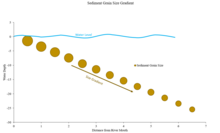20:
28:
331:
102:
Tangential sorting is the result of sediment being deposited in same direction as flow. Normal tangential sorting results in a gradient of sediment sizes deposited from largest to finest as they travel downstream. When sediments are deposited from smallest to largest as they travel downstream, this
145:
In reference to windblown sediment, a wide range of conditions such as distance and height of transport and varying wind patterns at the sediment source can affect grain size, rate of transport and distribution of sediment. Windblown sediment travels one of three ways--rolling,
156:
that is reworked by fluvial processes tends to have more poorly sorted sediment as compared to sediment sorted by only
Aeolian processes because loess particles become mixed with preexisting sediment of varying grain sizes within bodies of water.
82:
The terms describing sorting in sediments – very poorly sorted, poorly sorted, moderately sorted, well sorted, very well sorted – have technical definitions and semi-quantitatively describe the amount of variance seen in particle
54:. The degree of sorting is determined by the range of grain sizes in a sediment deposit and is the result of various transport processes (
372:
133:. As a result, studying the degree of sorting in deposits of sediment can give insight into the energy, rate, and/or duration of
106:
Rocks derived from well sorted sediments are commonly both porous and permeable, while poorly sorted rocks have low
74:
size, which refers to the individual size of a crystal in a solid. Crystallite is the building block of a grain.
111:
365:
391:
287:
241:
130:
396:
358:
99:
use graphical charts to accurately describe the sorting of a sediment using one of these terms.
134:
346:
288:"Grain size of fine-grained windblown sediment: A powerful proxy for process identification"
23:
Sediment consisting of well sorted grains (left) compared with poorly sorted grains (right).
186:
8:
171:
147:
125:
Sediment sorting is influenced by: grain sizes of sediment, processes involved in grain
126:
257:
307:
261:
196:
191:
63:
303:
299:
253:
51:
342:
166:
47:
31:
Distribution of grain sizes based on water depth and distance from river mouth.
385:
311:
265:
137:, as well as the transport process responsible for laying down the sediment.
96:
95:
indicates that the sediment sizes are similar (low variance). In the field,
220:
181:
71:
59:
201:
39:
27:
19:
338:
176:
107:
88:
43:
330:
67:
153:
55:
129:, deposition, and post-deposition processes such as
87:indicates that the sediment sizes are mixed (large
242:"Sorting in grain flows at the lee side of dunes"
383:
120:
366:
285:
227:, John Wiley & Sons, Chichester, 153 p.
373:
359:
70:, etc.). This should not be confused with
239:
26:
18:
16:Distribution of grain size of sediments
384:
77:
325:
281:
279:
277:
275:
235:
233:
140:
103:is referred to as reverse sorting.
13:
114:, particularly when fine grained.
14:
408:
272:
230:
329:
286:Vandenberghe, Jef (2013-06-01).
304:10.1016/j.earscirev.2013.03.001
240:Kleinhans, M. G. (2004-03-01).
225:Sedimentary rocks in the field
214:
38:describes the distribution of
1:
258:10.1016/S0012-8252(03)00081-3
207:
121:Processes involved in sorting
345:. You can help Knowledge by
7:
160:
10:
413:
324:
150:or suspension in the air.
337:This article related to
32:
24:
292:Earth-Science Reviews
246:Earth-Science Reviews
30:
22:
85:Very poorly sorted
78:Sorting parameters
33:
25:
392:Sedimentary rocks
354:
353:
197:Aeolian transport
192:Fluvial processes
141:Aeolian processes
52:sedimentary rocks
404:
375:
368:
361:
333:
326:
316:
315:
283:
270:
269:
237:
228:
218:
97:sedimentologists
412:
411:
407:
406:
405:
403:
402:
401:
397:Petrology stubs
382:
381:
380:
379:
322:
320:
319:
284:
273:
238:
231:
219:
215:
210:
163:
143:
123:
116:
80:
50:deposits or in
17:
12:
11:
5:
410:
400:
399:
394:
378:
377:
370:
363:
355:
352:
351:
334:
318:
317:
271:
229:
212:
211:
209:
206:
205:
204:
199:
194:
189:
184:
179:
174:
169:
167:Graded bedding
162:
159:
142:
139:
122:
119:
79:
76:
48:unconsolidated
15:
9:
6:
4:
3:
2:
409:
398:
395:
393:
390:
389:
387:
376:
371:
369:
364:
362:
357:
356:
350:
348:
344:
340:
335:
332:
328:
327:
323:
313:
309:
305:
301:
297:
293:
289:
282:
280:
278:
276:
267:
263:
259:
255:
252:(1): 75–102.
251:
247:
243:
236:
234:
226:
222:
217:
213:
203:
200:
198:
195:
193:
190:
188:
185:
183:
180:
178:
175:
173:
170:
168:
165:
164:
158:
155:
151:
149:
138:
136:
132:
128:
118:
117:
113:
109:
104:
100:
98:
94:
90:
86:
75:
73:
69:
65:
61:
57:
53:
49:
45:
41:
37:
29:
21:
347:expanding it
336:
321:
295:
291:
249:
245:
224:
221:Tucker, M.E.
216:
182:Soil texture
152:
144:
124:
115:
112:permeability
105:
101:
92:
84:
81:
46:, either in
35:
34:
93:well sorted
91:); whereas
72:crystallite
60:debris flow
386:Categories
208:References
202:Grain Size
187:Deposition
135:deposition
40:grain size
339:petrology
312:0012-8252
298:: 18–30.
266:0012-8252
148:saltation
131:winnowing
127:transport
44:sediments
223:, 1996,
177:Porosity
172:Rounding
161:See also
110:and low
108:porosity
89:variance
68:glaciers
36:Sorting
310:
264:
83:sizes.
56:rivers
341:is a
154:Loess
343:stub
308:ISSN
262:ISSN
64:wind
300:doi
296:121
254:doi
42:of
388::
306:.
294:.
290:.
274:^
260:.
250:65
248:.
244:.
232:^
66:,
62:,
58:,
374:e
367:t
360:v
349:.
314:.
302::
268:.
256::
Text is available under the Creative Commons Attribution-ShareAlike License. Additional terms may apply.

